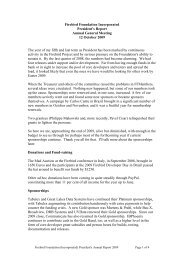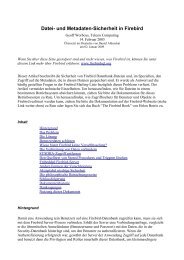Firebird 2.1 Language Reference Update
Firebird 2.1 Language Reference Update
Firebird 2.1 Language Reference Update
Create successful ePaper yourself
Turn your PDF publications into a flip-book with our unique Google optimized e-Paper software.
Transaction control statements<br />
If the supplied name exists already within the same transaction, the existing savepoint is deleted and a new one<br />
is created with the same name.<br />
If you later want to rollback your work to the point where the savepoint was created, use:<br />
ROLLBACK [WORK] TO [SAVEPOINT] name<br />
ROLLBACK TO SAVEPOINT performs the following operations:<br />
• All the database mutations performed within the transaction since the savepoint was created are undone. User<br />
variables set with RDB$SET_CONTEXT() remain unchanged.<br />
• All savepoints created after the one named are destroyed. All earlier savepoints are preserved, as is the savepoint<br />
itself. This means that you can rollback to the same savepoint several times.<br />
• All implicit and explicit record locks acquired since the savepoint are released. Other transactions that have<br />
requested access to rows locked after the savepoint must continue to wait until the transaction is committed or<br />
rolled back. Other transactions that have not already requested the rows can request and access the unlocked<br />
rows immediately.<br />
The internal savepoint bookkeeping can consume huge amounts of memory, especially if you update the same<br />
records multiple times in one transaction. If you don't need a savepoint anymore but you're not yet ready to end<br />
the transaction, you can delete the savepoint and free the resources it uses with:<br />
RELEASE SAVEPOINT name [ONLY]<br />
With ONLY, the named savepoint is the only one that gets released. Without it, all savepoints created after it<br />
are released as well.<br />
Example DSQL session using a savepoint:<br />
create table test (id integer);<br />
commit;<br />
insert into test values (1);<br />
commit;<br />
insert into test values (2);<br />
savepoint y;<br />
delete from test;<br />
select * from test; -- returns no rows<br />
rollback to y;<br />
select * from test; -- returns two rows<br />
rollback;<br />
select * from test; -- returns one row<br />
Internal savepoints<br />
By default, the engine uses an automatic transaction-level system savepoint to perform transaction rollback.<br />
When you issue a ROLLBACK statement, all changes performed in this transaction are backed out via a transaction-level<br />
savepoint and the transaction is then committed. This logic reduces the amount of garbage collection<br />
caused by rolled back transactions.<br />
When the volume of changes performed under a transaction-level savepoint is getting large (10 4 –10 6 records<br />
affected), the engine releases the transaction-level savepoint and uses the TIP mechanism to roll back the transaction<br />
if needed.<br />
91

















